Discover Ancient Etruria: Tuscania and Tarquinia's Etruscan Legacy and Splendor
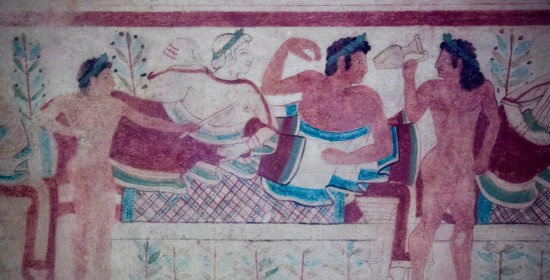
Buongiorno and welcome to Stefano Rome Tours, Rome’s premier tour company for private Italy Tours, and Private Excursions from Civitavecchia.
Located in the heart of Italy that was once known in antiquity as Etruria, Tuscania and Tarquinia invite travelers and cruisers to embark on a captivating journey through the annals of history on our popular Etruscan Mystery countryside tour from Rome and from Civitavecchia.
Tuscania and Tarquinia
Discover Etruscan Legacy and Splendor
These two ancient Etruscan cities that later took on their uniquely charming Medieval characteristics offer a glimpse into the enigmatic past of a remarkable civilization. Tuscania, whose origins trace back to the 8th century BC as an Etruscan city, reveals an archaeological treasure trove of ancient tombs, sarcophagi, and artifacts showcased in the town’s Etruscan Museum.
Tarquinia, one of the most prominent Etruscan city-states in the Etruscan League, is renowned for its Monterozzi Necropolis and an acclaimed Archaeological Museum. Here, the unique-in-the-world painted tombs provide entrancing insights into the Etruscan world.
With each step you take in Tuscania and Tarquinia, you not only embark on a historical adventure but also delve deep into the mysteries of the Etruscan civilization, creating an unforgettable journey through the echoes of ancient splendor.
Tuscania and Tarquinia are important not just because they are repositories of invaluable archaeological treasures, but also because they offer a tangible connection to the bygone Etruscan civilization that predates the Roman Empire. Exploring their hallowed grounds and visiting the meticulously preserved painted tombs is like stepping through a portal in time. It's a chance to immerse oneself in a world where the Etruscans thrived, revealing their customs, artistry, and spirituality.
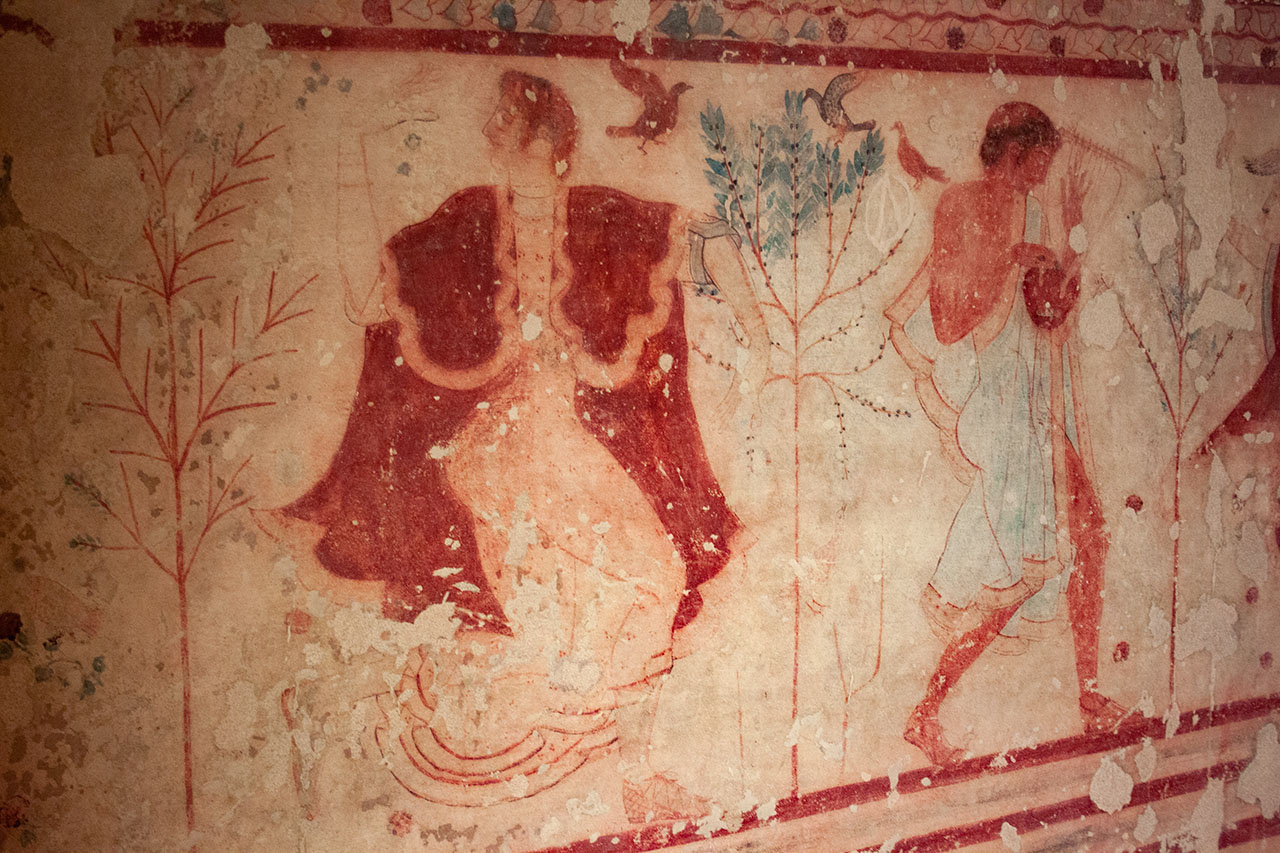
By visiting both Tuscania and Tarquinia on a day trip from Rome or a shore excursion from Civitavecchia, you embark on an extraordinary odyssey to understand the essence of a civilization shrouded in mystery, and in doing so, you contribute to the preservation of a rich and enigmatic heritage that continues to captivate the imagination of history enthusiasts and scholars worldwide.
Before we dive into Tuscania and Tarquinia's Etruscan legacy, let's find out more about these mysterious Etruscans!
The Mysterious Etruscans: Shapers of Italy's History
Long before the dawn of the Roman Empire, the Italian Peninsula was home to a formidable civilization that still entices scholars, history aficionados, and discerning travelers today – the Etruscans. Flourishing between the 8th and 3rd centuries BCE, their legacy was not just a historical footnote but a transformative era that laid the foundation for Italy's subsequent cultural evolution.
Settled in central Italy which was then known as Etruria, the Etruscans were at the crossroads of Mediterranean trade and cultural exchange, exposed to a wealth of ideas, technologies, and artistic influences. This proximity enriched their culture, resulting in a unique blend of Greek, Phoenician, and indigenous Italian elements.
You might ask yourself:
Why were the Etruscans important in Italy's history?
The Etruscans, often overshadowed by their Greek contemporaries, were pioneers in multiple fields, constituting an advanced civilization that rivaled the achievements of the Greeks.
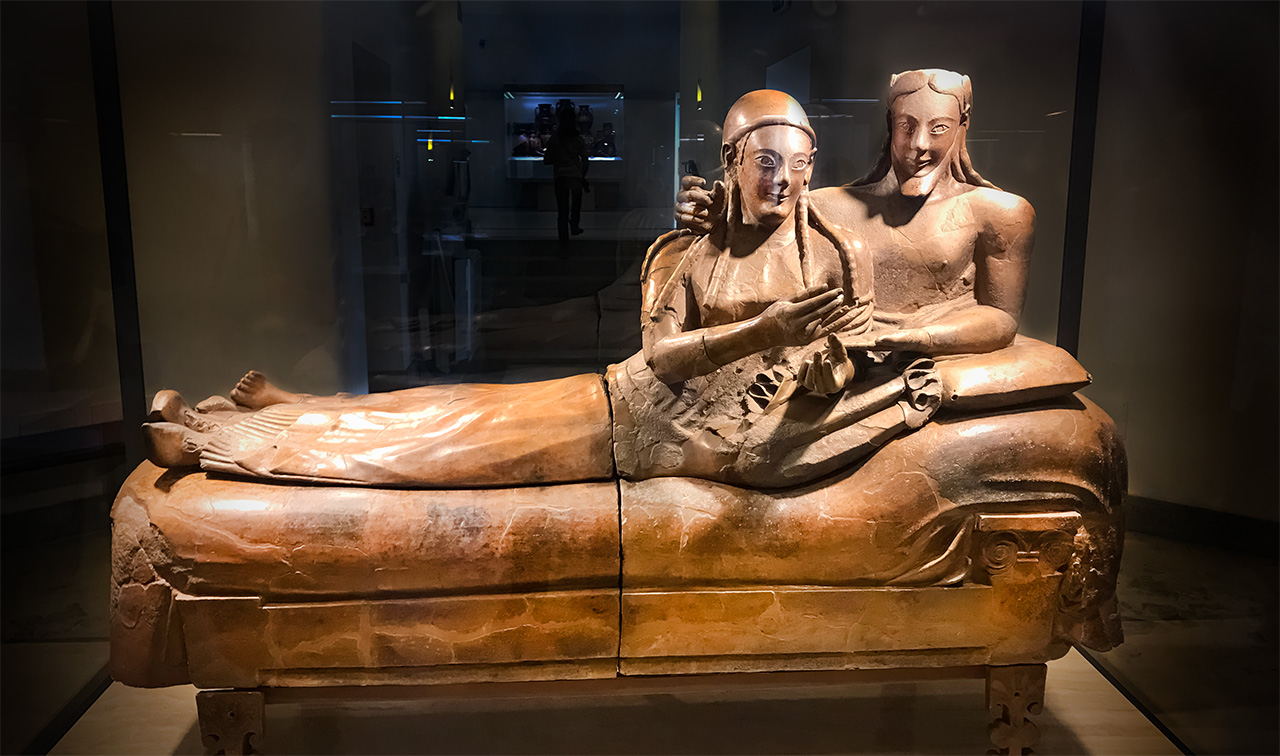
Their metalwork was renowned for intricate designs and craftsmanship, setting a high standard in the ancient world. Their pottery, adorned with intricate patterns, served both functional and aesthetic purposes, foreshadowing the exquisite Roman ceramics of later centuries.
Their sarcophagi, as seen in the iconic Etruscan Sarcophagus of the Spouses (see the photo above) influenced Roman art and funerary traditions. When the Etruscans were at their peak, Rome was a primitive village on a hill.
In terms of architecture, the Etruscans engineered impressive cities like Tarquinia and Tuscania (as well as Rome itself), boasting complex drainage systems, grand temples, and innovative arches – a feature that would define Roman architecture for centuries to come. Without the highly advanced Etruscans, these amazing innovations may not have existed as the Romans expanded on the existing foundation established by the Etruscans.
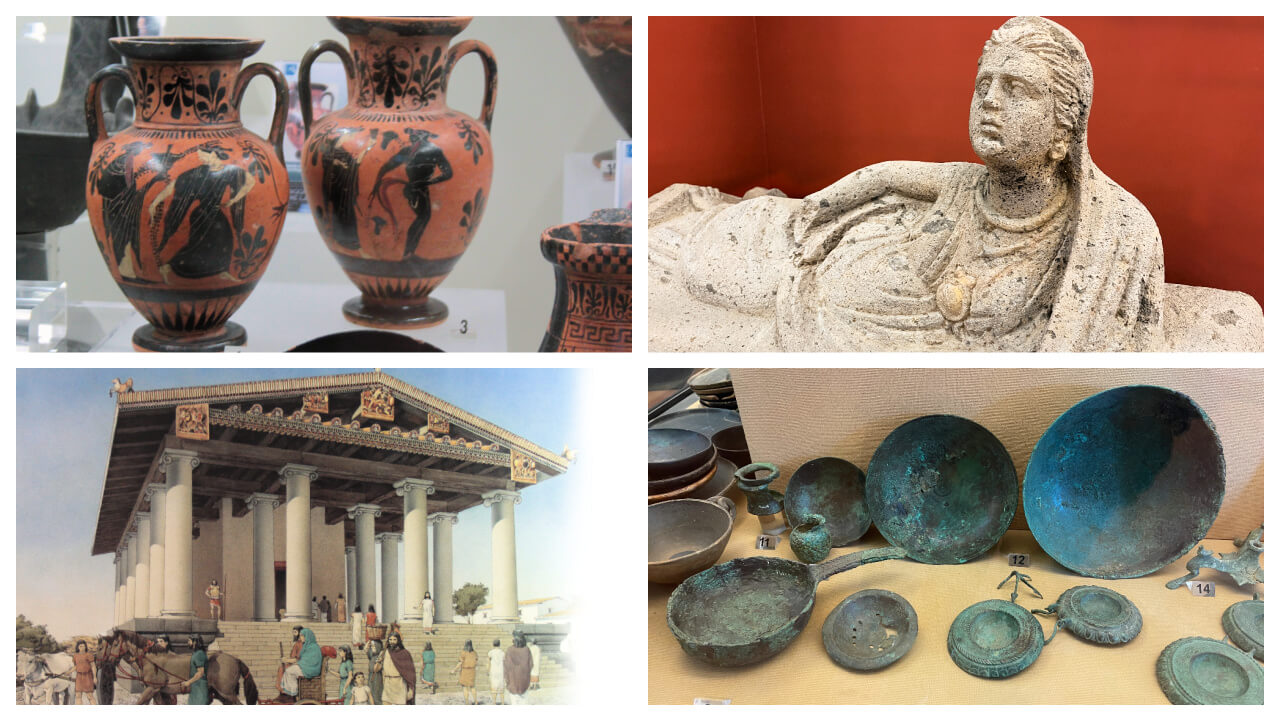
Spirituality was at the heart of Etruscan life, with beliefs deeply rooted in nature and the cosmos. Their divination practices, such as reading bird flights and sacrificial entrails, heavily influenced Roman rituals. For the Etruscans, life transcended death, as evident in their remarkable frescoed tombs in Tarquinia. These subterranean chambers provide a window into their beliefs and rituals, allowing us to step back in time and connect with this ancient civilization.
Yet, one of the greatest mysteries surrounding the Etruscans is their language, still largely undeciphered. This linguistic enigma adds an extra layer of intrigue to their legacy, leaving us with tantalizing fragments and inscriptions that hint at its complexity.
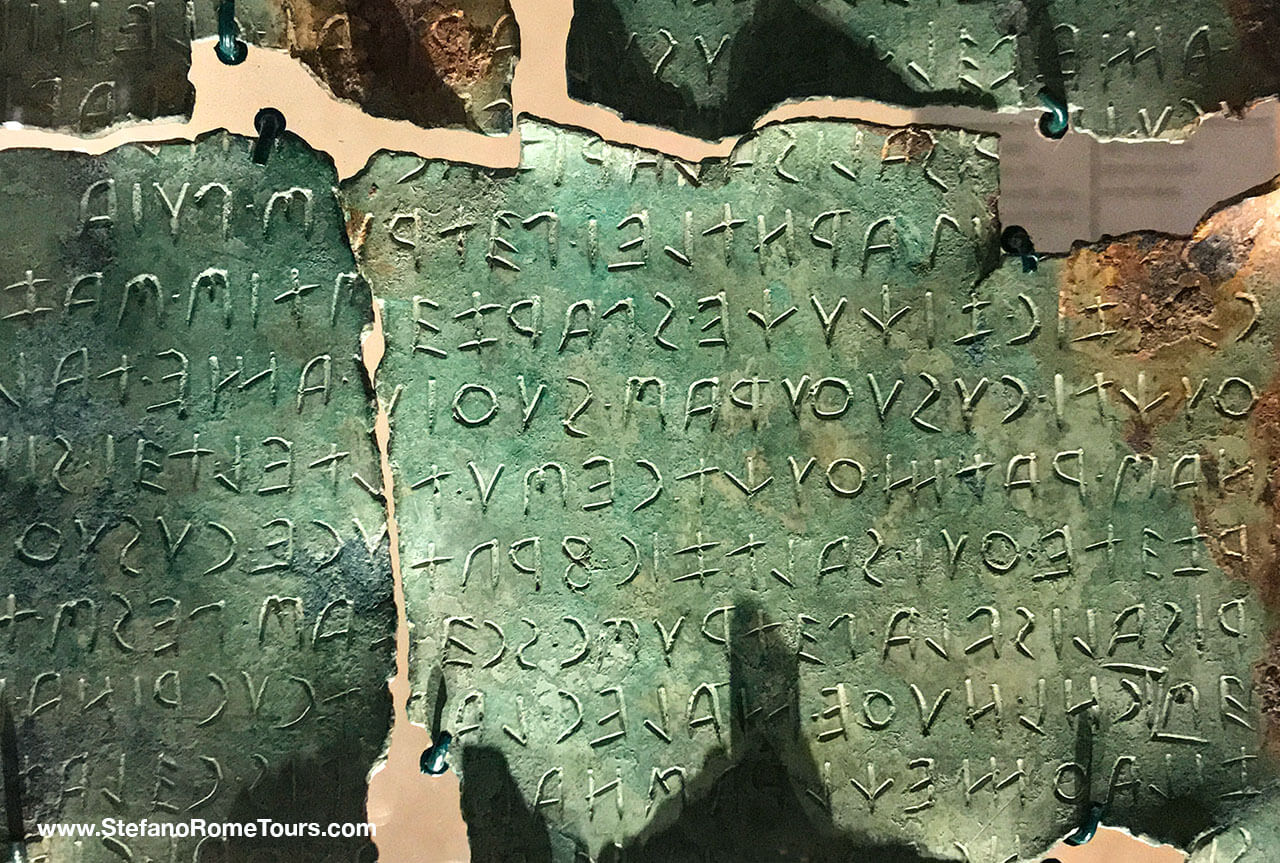
The early Romans either assimilated or expanded upon the pre-existing Etruscan knowledge and achievements. Devoid of the Etruscans as their foundational influence, Rome might not have risen to the pinnacle of greatness and power that it ultimately achieved.
The enduring legacy of the Etruscans lives on through the names of Italian regions, cities, and even the sea itself! The Tyrrhenian Sea, for instance, was named after Etruscans, who were referred to as the "Tyrrhenians" by the ancient Greeks. Similarly, regions like Tuscany and cities like Tuscania owe their names to the Latin term "Tusci" which was used by the Romans to identify the Etruscans. It's a testament to how the echoes of history still resonate in the modern landscape of Italy.
In essence, the Etruscans remain an important yet enigmatic chapter in Italy's history, a civilization that has left an indelible mark, from their metallurgy to their language, from architectural marvels to their profound spirituality.
To explore the world of the Etruscans is to embark on a journey through time to Tuscania and Tarquinia, unearthing the mysteries of Italy's enigmatic forebears.
Tuscania: Echoes of the Etruscan Heritage
About an hour and a half from Rome or 40 minutes from Civitavecchia, lies the picturesque town of Tuscania, an unassuming town that has etched the Etruscan legacy into its very soul. Tuscania, known as "Tuscanium" or "Tuscana" in ancient times, harbors a history intertwined with its identity as an Etruscan city.
Dating back to the 8th century BC, Tuscania's Etruscan origins tell a story of advanced culture, including art, religion, and architecture. It became a prominent member of the Etruscan League, a confederation of Etruscan cities that thrived during their heyday.
Situated strategically on elevated terrain, Tuscania controlled vital trade routes and enjoyed natural defenses, contributing to its prosperity. This geographical advantage facilitated trade and cultural exchanges with neighboring Etruscan cities, as well as with civilizations such as the Greeks and Phoenicians. The result was a cultural melting pot that enriched Tuscania's heritage.
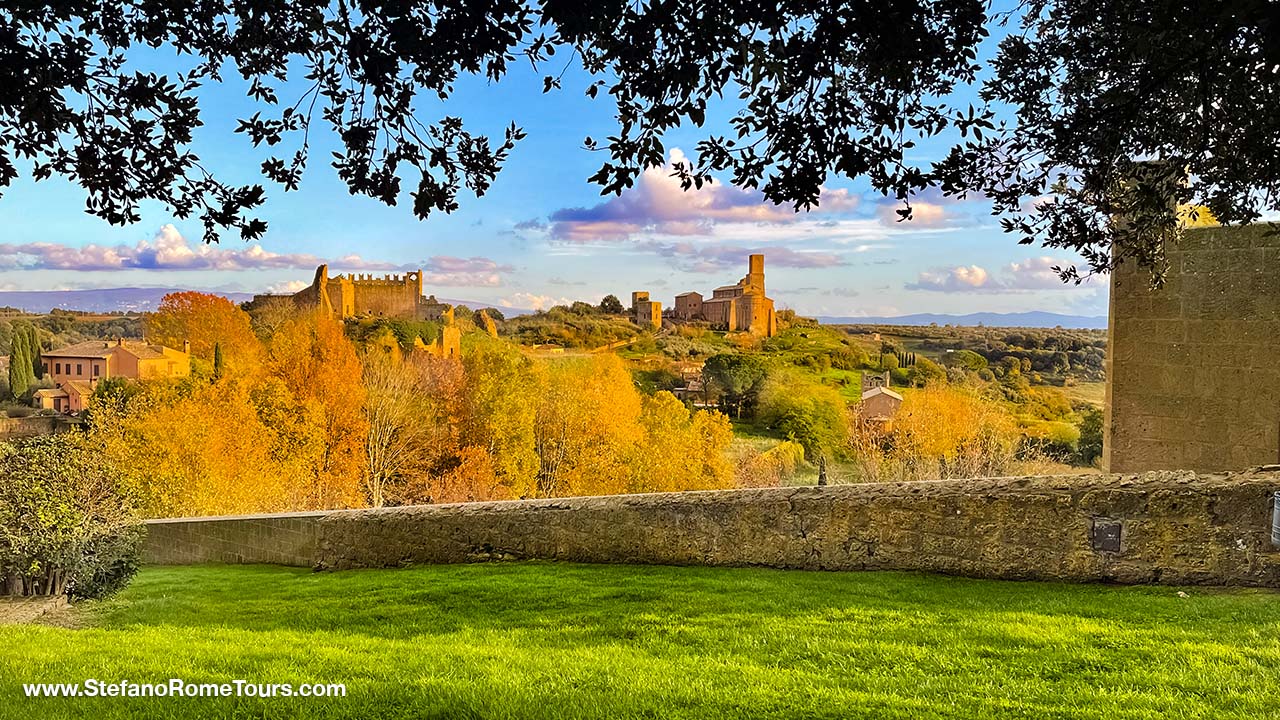
Etruscan architectural innovation manifested in Tuscania through temple structures and the creation of underground burial chambers known as hypogea. The Etruscans' artistic flair, reflected in their intricate pottery and sculpture, incorporated intricate designs and symbolism, many of which still grace museums today.
As the Roman Republic's dominance expanded across the Italian Peninsula, Tuscania, like other Etruscan city-states, gradually succumbed to Roman rule. This marked the end of the Etruscan era, ushering in a new chapter infused with Roman customs and culture.
Visiting Tuscania - A Journey Through Time
Today, Tuscania stands as a living testament to its Etruscan roots while embracing the influences of subsequent civilizations. Etruscan remnants can be discovered throughout the town, a testament to its enduring identity as an Etruscan city.
While strolling through Tuscania, you'll encounter a landscape adorned with Etruscan sarcophagi. Tuscania's wealth of Etruscan heritage is so abundant that museums alone cannot contain it all. While most sarcophagi reside in prestigious museums across Italy and Europe, in Tuscania some of these 2500-year-old marvels find an unconventional resting place in Tuscania's Piazza Franco Basile and in the vicinity of Saint Peter's church, where they stand as open-air adornments resilient against the passage of time, bearing witness to history.
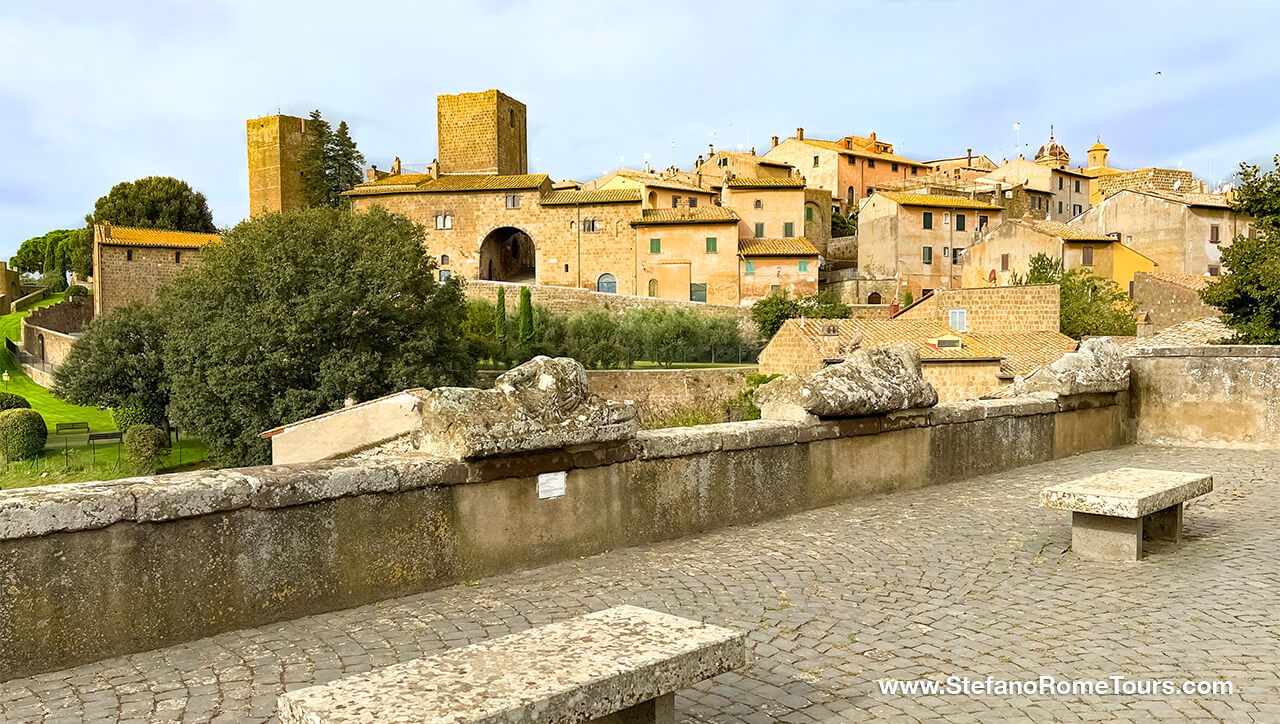
Tuscania also boasts several Etruscan burial sites and tombs scattered across the surrounding countryside. While they require a bit of effort to access and are not all open for visits, they serve as silent witnesses to the ancient Etruscan funerary practices.
Although venturing into Etruscan tombs in Tuscana may not be feasible, visitors have the opportunity to immerse themselves in the Etruscan heritage by exploring the Etruscan Museum, conveniently located within the 13th-century Franciscan convent, adjacent to the Church of S. Maria del Riposo.
Inside the museum, a captivating collection of artifacts, sarcophagi, pottery, and bronze sculptures unfolds, providing an intimate glimpse into the daily lives of these mysterious inhabitants who once thrived in this region. As you peruse the museum's treasures, you'll inevitably develop a profound appreciation for the Etruscans' exceptional craftsmanship and their deep-rooted connection to the land.
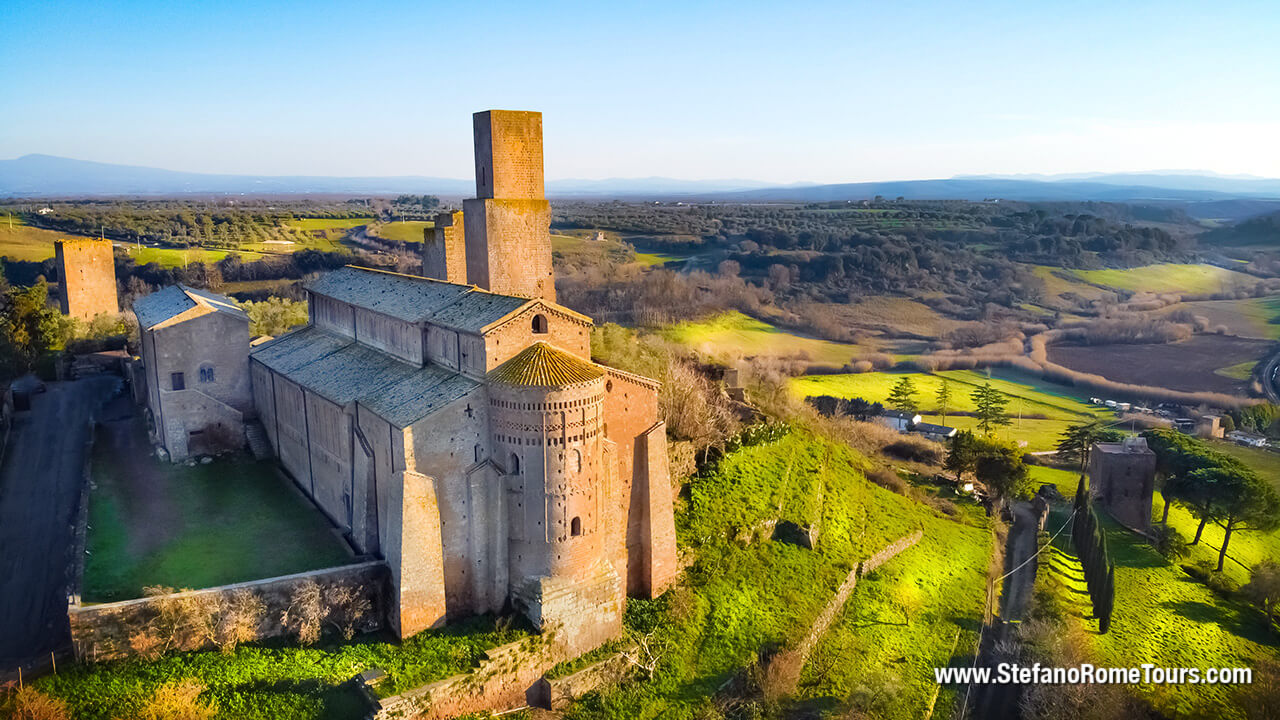
While in Tuscania, behold Colle San Pietro (St Peter’s Hill), once an Etruscan Acropolis, that casts a watchful gaze over the sprawling countryside. The terraced hillside and ancient ruins carry echoes of the ancient society that once thrived here some 2,500 years ago. The hill is crowned by the 8th-century Romanesque Saint Peter's Church, believed to have been built upon an Etruscan temple's ancient foundations.
Ascending to San Pietro's vantage point, you are greeted by breathtaking vistas that steal your breath away. Behold the haunting ruins of Castello del Rivellino, a medieval fortress that defiantly bears the scars of time's relentless passage. Gaze upon the indomitable medieval defensive walls that once embraced and safeguarded Tuscania. Revel in the majesty of the resplendent stone buildings and towering edifices, stoic sentinels that dutifully safeguard the echoes of a rich millennium's tapestry of history.
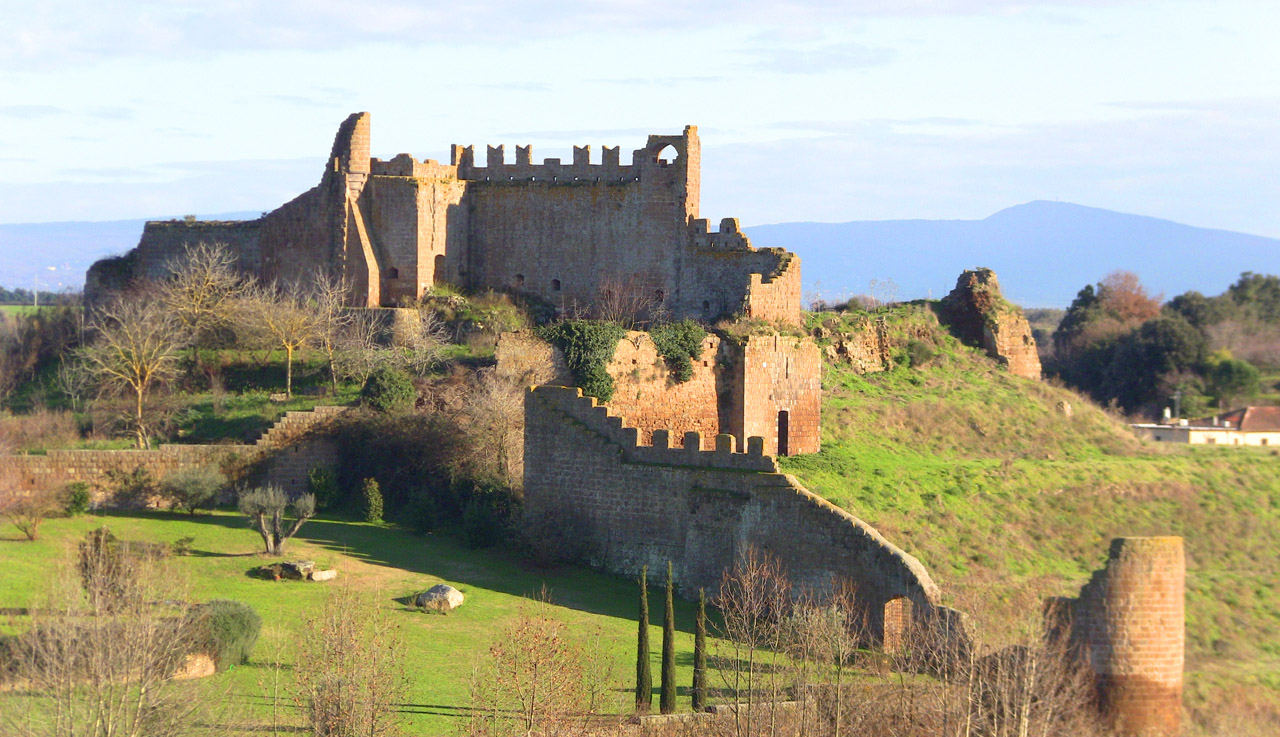
At the foot of Colle San Pietro, you will discover Santa Maria Maggiore Church. This architectural gem features an intricately sculpted facade adorned with delicate rose windows and detailed motifs. Inside, medieval frescoes dating back to the 14th century adorn the walls, depicting saints and biblical scenes.
The church's elegant blend of Romanesque and Gothic architecture invites quiet reflection and preserves Tuscania's cultural legacy, making it a must-visit for those seeking to immerse themselves in history and art.
TARQUINIA - Discover Ancient Etruscan Marvels
Tarquinia, a living testament to the captivating history of the Etruscans, an enigmatic and influential civilization that once thrived on the Italian Peninsula, beckons explorers to delve into its rich past.
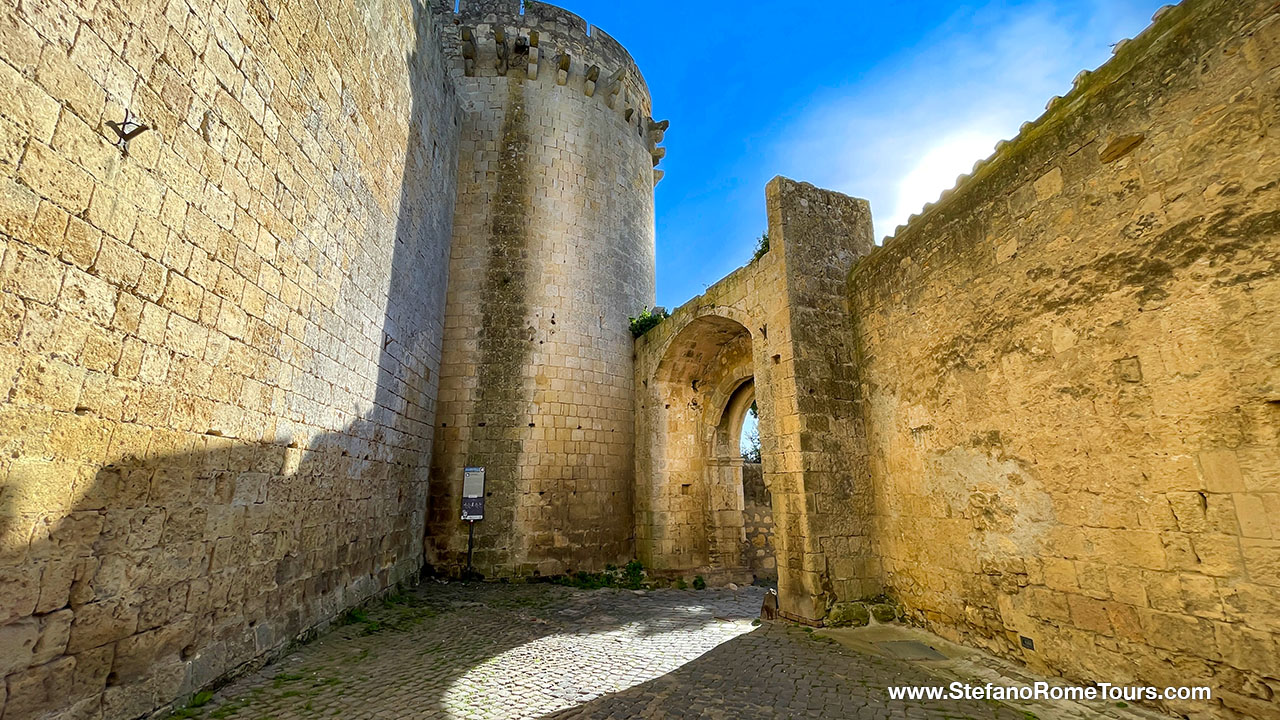
With roots extending deep into antiquity known as Tarquinii, the city's derived from Tarchon, a revered figure in Etruscan mythology and its legendary founder, speaks to its storied history dating back to around the 12th century BC. Located along the coast, Tarquinia flourished as a prominent member of the Etruscan League, securing its place among the "twelve cities" of this ancient confederation.
Tarquinia's strategic location atop a plateau overlooking the Tyrrhenian Sea was a key factor in its prominence. This vantage point offered natural defenses, security, and access to maritime trade routes. It facilitated trade with Greek colonies in the south and Phoenician settlements in the west, enriching the city's culture. The fertile surrounding plains supported agriculture, contributing to the city's growth and prosperity.
The city's political landscape mirrored that of other Etruscan counterparts, characterized by an aristocratic ruling class. Eminent Etruscan noble families, such as the Tarquinii and the Velianas, wielded considerable power and authority for extended periods, governing effectively and contributing to monumental developments that would shape history.
Notably, the Tarquinian Dynasty produced influential rulers like Tarquinius Priscus and Tarquinius Superbus, who ruled Rome as kings during its formative years as a monarchy. Their reigns played pivotal roles in molding early Roman history and architectural legacies, marking a crucial juncture in Rome's transition from monarchy to republic.
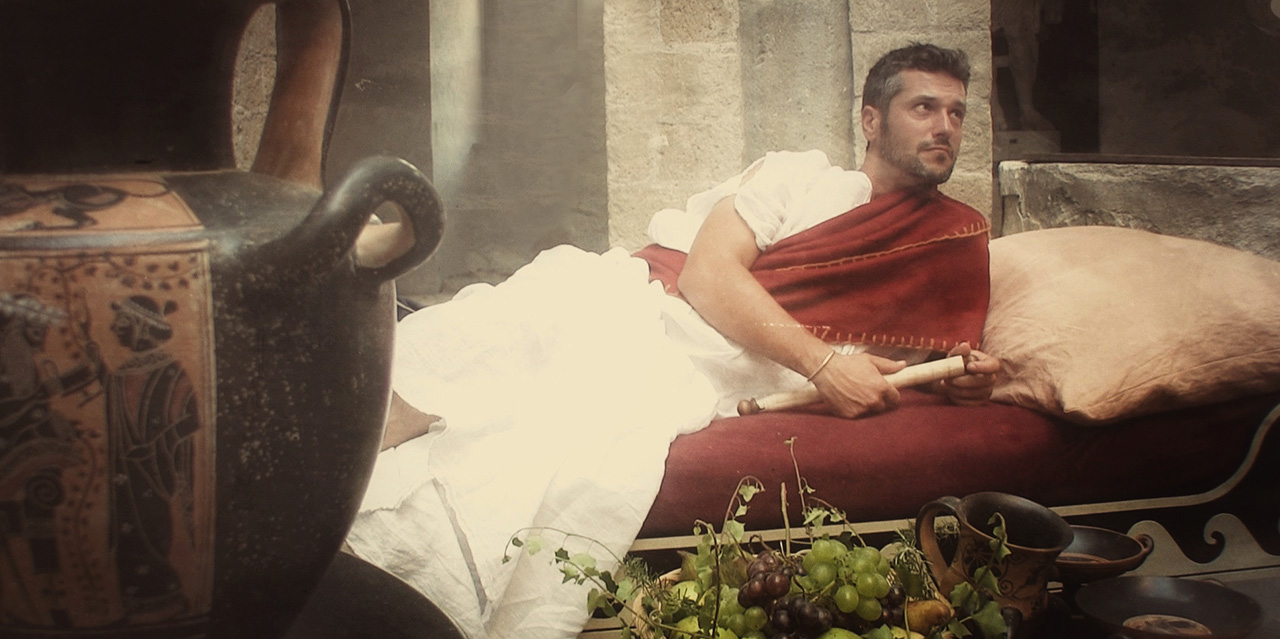
Monterozzi Necropolis - Tarquinia’s Hidden Painted Tombs
The city's most exceptional treasures await within the Monterozzi necropolis, where intricate frescoed tombs offer glimpses into the Etruscans' spiritual beliefs and daily lives. Spanning from the late 7th century BC's Orientalizing Period to the mid-1st century BC of the Roman Republic, this uninterrupted tradition has earned Tarquinia a place on the UNESCO World Heritage Site list since 2004. These elaborate frescoed tombs were commissioned by individuals of higher social status and wealth within Etruscan society, reserved for the elite, reflecting prestige and status.
Discover the hidden wonders of Monterozzi Necropolis on the outskirts of Tarquinia, where underground burial chambers reveal an intriguing world of Etruscan art and tradition. These subterranean tombs, adorned with vibrant frescoes, offer a unique glimpse into the mysterious Etruscan civilization, blurring the lines between life and the afterlife. These exquisite paintings, created by the elite aristocracy, are carved into solid rock and hold the secrets of a bygone era.
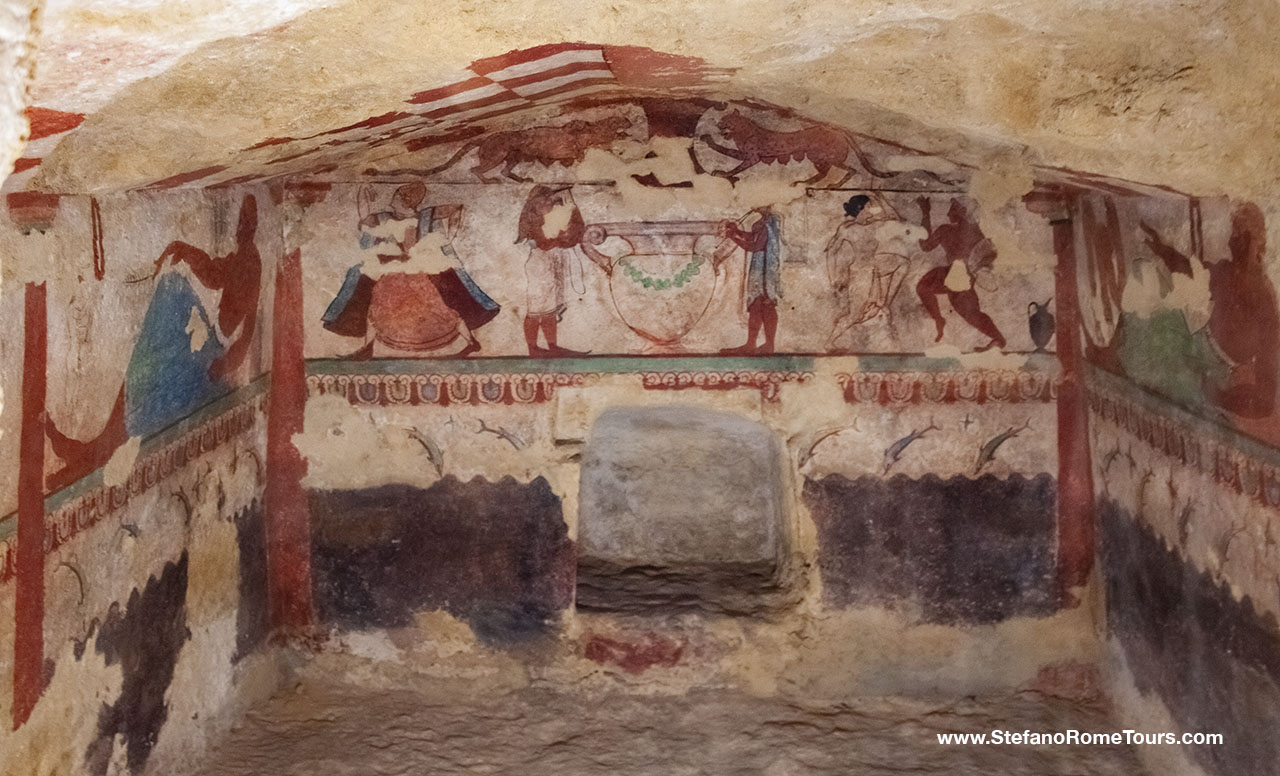
Tarquinia, among the most significant Etruscan towns, represents the pinnacle of the tradition of decorating burial chambers with artwork. These frescoes tell stories of death as a continuation of life, where departed souls find their eternal resting place where their earthly journey ends.
These painted tombs, constituting a mere 3% of Tarquinia's extensive tomb collection, are the exclusive creations of the elite aristocracy. Crafted as hypogean burial chambers, they were elegantly carved into solid stone, their entrances gracefully sloping downward.
The earliest tombs, designed for married couples, feature intimate chambers with elegant double-sloped ceilings. As the Hellenistic age unfolded, these chambers expanded to accommodate entire families, marking an evolution in Etruscan burial practices.
Within these tombs, frescoes offer invaluable glimpses into Etruscan life and their views on death. Vivid depictions adorned tomb walls, narrating scenes of aristocratic life, from banquets and dances to hunts, athletic games, and poignant funeral rites. For instance, the Tomb of the Leopards invites you to partake in a joyous banquet scene, celebrating life's vibrancy.
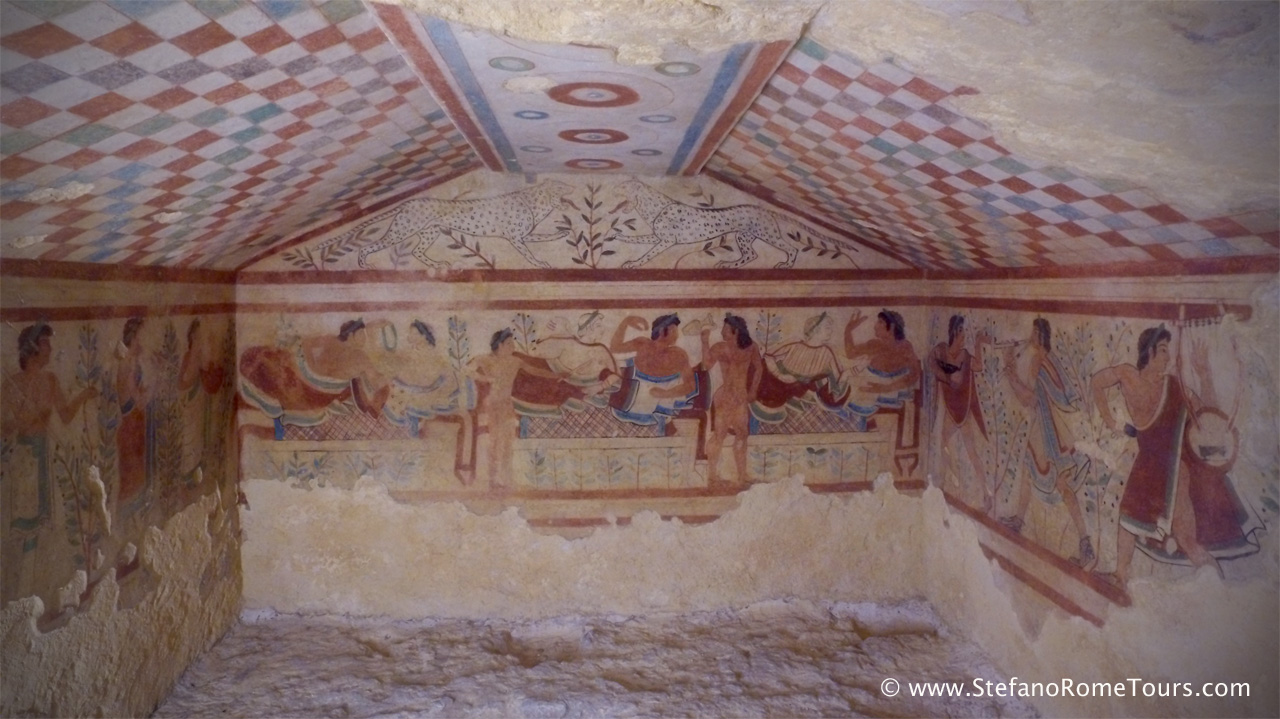
The latter half of the 4th century BC marked a turning point influenced by Greek culture and the encroaching Roman influence by the 3rd century BC. Sinister figures from Greek mythology, such as Charun and Vanth, emerged in tomb paintings.
In the Anina Tomb, named after Tarquinia's prominent Anina family, these eerie figures come to life. The formidable Charun, with his ethereal blue skin, wields a menacing hammer, while the equally cerulean Vanth clutches a torch, guiding souls into the afterlife. This portrayal creates an eerie yet captivating atmosphere within the tomb.
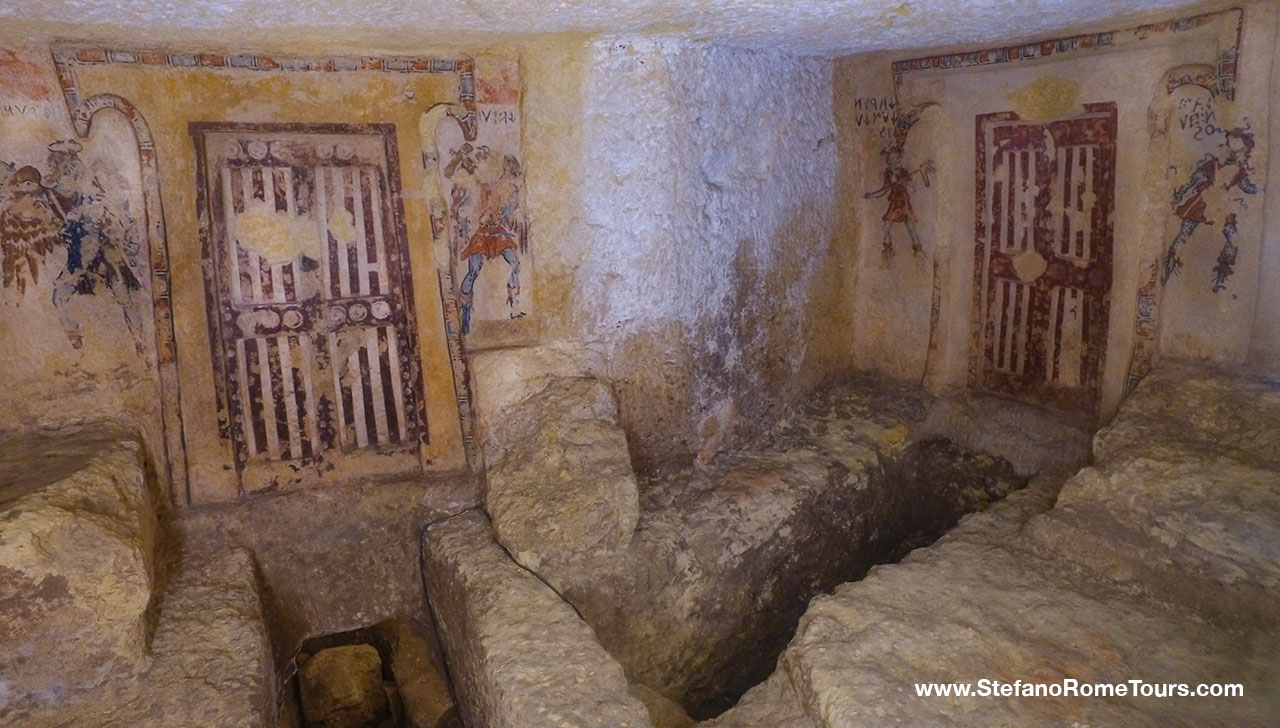
These painted tombs narrate the evolution of the Etruscan civilization, offering a profound connection to the past through meticulously crafted paintings. It's a journey that bridges centuries and captivates the imagination.
Grave goods, including precious jewelry, metal objects, and intricate pottery, manifest tangible expressions of the Etruscan belief in an afterlife, where these valuables would accompany the departed. These artifacts not only captivate researchers but also grace museum exhibits such as the National Archeological Museum of Tarquinia which offers visitors like you a chance to delve into Etruscan history and appreciate their intricate customs and beliefs. These artifacts bridge time's gap, connecting us to a civilization that still inspires intrigue and wonder.
Following the Etruscans and the Romans, Tarquinia evolved into a medieval stronghold. Today, it still retains its charming Medieval character with imposing city walls and lofty towers. As you stroll along the town's storied streets, you'll find yourself in a world where history, legend, and discovery converge, offering a profound connection to Italy's rich past.
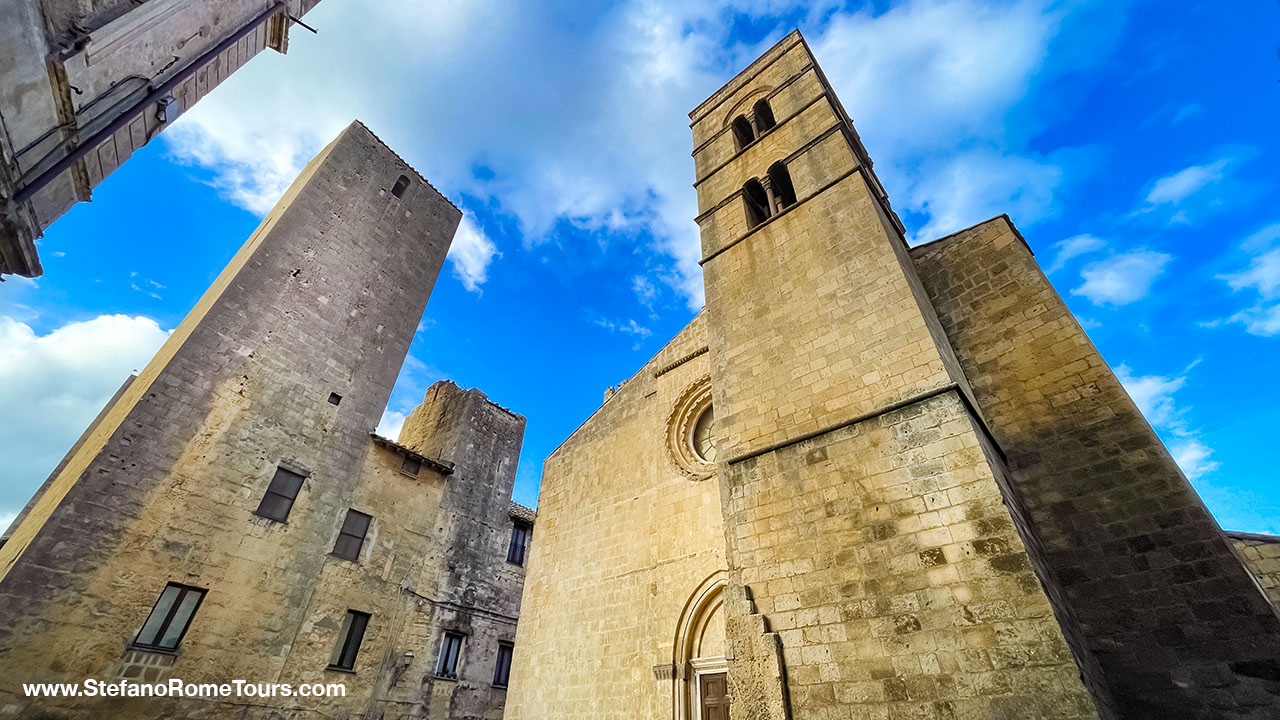
As you've immersed yourself in the captivating tale of Tuscania and Tarquinia's Etruscan legacy, consider this just the beginning of the extraordinary journey that awaits you on our Etruscan Mystery Tour from Rome or Shore Excursion from Civitavecchia.
Whether you consider yourself an intrepid traveler or a curious cruiser, your adventure through ancient Etruria promises an unforgettable journey through history, where every step reveals a piece of the Etruscan puzzle, leaving you with a profound connection to this remarkable civilization. So, don't miss your chance to be part of this extraordinary excursion, where the legacy of Tuscania and Tarquinia beckons you to explore, learn, and uncover the mysteries of an ancient civilization that still resonates today. Book your Etruscan Mystery Tour from Rome or from Civitavecchia and become a living testament to the timeless splendor of Etruria.
Thank you for reading our travel blog and for choosing Stefano Rome Tours for your private tours in Italy and Civitavecchia shore excursions. We look forward to sharing amazing places in Italy with you!
